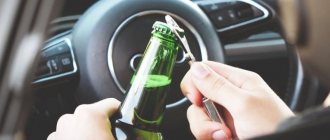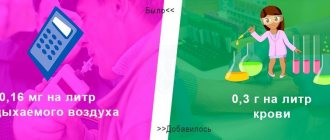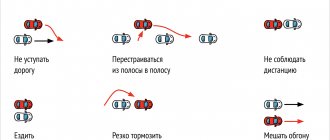Changes in the law
Changes are made in a note to Article 12.8 of the Code of Administrative Offenses of the Russian Federation. The article defines the responsibility for driving a vehicle by drivers who are in a state of intoxication.
| BEFORE | AFTER |
| Note. Administrative liability provided for by this article and part 3 of article 12.27 of this Code occurs in the event of an established fact of consumption of substances that cause alcohol intoxication, which is determined by the presence of absolute ethyl alcohol in a concentration exceeding the possible total measurement error, namely 0.16 milligrams per liter of exhaled breath. air, or in the case of the presence of narcotic drugs or psychotropic substances in the human body. | Note. Administrative liability provided for by this article and part 3 of article 12.27 of this Code occurs in the event of an established fact of consumption of substances that cause alcohol intoxication, which is determined by the presence of absolute ethyl alcohol in a concentration exceeding the possible total measurement error, namely 0.16 milligrams per liter of exhaled breath. air, or the presence of absolute ethyl alcohol in a concentration of 0.3 or more grams per liter of blood, or in the case of the presence of narcotic drugs or psychotropic substances in the human body. |
The concept of ppm has not existed in Russia for several years
Paradoxical as it may seem, now this concept is simply not in the legislation. The story of why this happened is truly a detective story.
As many drivers remember, at one time the state tried to radically solve the problem of drunk driving and introduced the concept of absolute zero blood alcohol content.
Before this absolute zero appeared, the law clearly stated that the maximum alcohol content should be 0.15 mg per liter of air when exhaled, or 0.3 ppm in the blood (that's 0.3 grams per liter blood).
With the introduction of absolute zero, all these norms were removed from the law, and any percentage of alcohol content was recognized as a crime. The government tried to radically solve the problem in this way, and the general plan is quite clear. There is a certain category of marginal drivers, criminally irresponsible people who believe that if there is a certain acceptable level of alcohol, then there is nothing wrong with drinking and driving. Such drivers even have certain ideas about how many milligrams of beer or wine they can drink so as not to exceed the limit. Even without being particularly intelligent, such people drank, got behind the wheel and caused accidents, injuring and killing other people and themselves.
There would be nothing wrong with such a radical solution to this problem as absolute zero, if not for some nuances that were mentioned right away, and which the government did not listen to.
So, in some cases, the driver must take certain medications prescribed by his doctor and containing a tiny dose of alcohol. Alcohol is also something that is produced by the body itself, albeit in minute quantities. A tiny dose of alcohol that does not affect the reaction and speed of decision-making may be contained in kefir or kvass, etc. Finally, the breathalyzer devices themselves, which are used by traffic police inspectors, have a certain error.
As a result, many drivers were deprived of their licenses for hundredths of alcohol found in their breath for various reasons. They moved away from absolute zero as an erroneous decision, and the norm on the permissible minimum breathalyzer reading of 0.16 mg of alcohol per liter of exhaled air returned to the laws. This is the error of the breathalyzer itself. At the same time, they simply forgot about returning the concept of ppm of alcohol in the blood. To date, this minimum is simply not prescribed.
What changes for drivers?
Blood alcohol content is determined in a laboratory.
Alcohol can be detected either by the alcohol content in the exhaled air or by the alcohol content in the blood. The alcohol content in the blood can only be determined in a laboratory with blood sampling. When blowing through a breathalyzer, it is possible to determine only the alcohol content in the exhaled air.
My breathalyzer shows ppm, how can that be? It's simple - “ppm” is calculated using the formula 1 ppm = 0.45 mg/l. This is a very simplified method and cannot be used in administrative matters.
In fact, nothing changes for ordinary blowdowns. The need to determine the alcohol content in the blood arises when a person is physically unable to exhale (too much intoxication, is unconscious, or in the event of death as a result of an accident). The permissible alcohol limit in 2021 remains virtually the same, but it can now be determined in two ways. Moreover, in a normal situation, taking a blood test is hardly justified.
Interesting on the topic: Testing for driver intoxication. Intoxication testing laws. Fine for driving without a license.
Permissible alcohol limit while driving in ppm
Of course, the inspector will not check you for alcohol if there are no certain signs of intoxication and the person is in normal condition. The law requires you to undergo an examination if you have the following symptoms:
- slurred and incoherent speech of the driver;
- unnaturally reddened skin on a person’s face;
- unsteady gait and unnatural posture;
- characteristic smell of alcoholic drinks;
- unstable psychological and emotional state.
All of these symptoms usually appear after drinking alcoholic beverages. If there are characteristic signs, the inspector must draw up an inspection report and send the driver for a medical check.
On-site measurements of ppm are made with a breathalyzer in the exhaled air. Such measurements must take place in the presence of witnesses and the result of the inspection is reflected in the report. In the document, the inspector describes all identified signs of intoxication, information about all persons present during the measurement (full name, address, contact phone number), the amount of intoxication in ppm, as well as the date and time of detection of the violation of the law.
In the event that the driver refuses to undergo the examination or the device shows zero values, he is sent to a medical facility to re-measure the amount of alcohol in the person’s blood, but using a blood test. If you refuse the study, you will definitely be deprived of your right to drive a car for driving while drunk.
In 2021, the permissible standard has not changed compared to last year; it is equal to 0.16 ppm. Therefore, if the device detects a larger number, an administrative violation report will be drawn up against the driver.
It is worth remembering that there are a lot of products, the consumption of which can show a small amount of alcohol on a traffic inspector’s device:
- nonalcoholic beer;
- chocolate candies;
- kefir and other sourdough products;
- kvass;
- sandwich made from black bread and sausage, etc.
Each of these products contains a certain amount of alcohol, which is excreted only after some time. For several years (from 2010 to 2013), this led not only to financial sanctions, but also to the deprivation of the rights of many inexperienced drivers. After many trials, it was decided to abolish the zero ppm and establish a new standard - 0.16 ppm.
In 2021, a certain amendment to the law was adopted; if the driver is unable to exhale into a breathalyzer, for example, in the case of severe intoxication or unconsciousness, then in this case it is possible to take a blood test of the person and determine the degree of his intoxication. If the indicator is higher than 0.35 ppm, then, of course, the offender will not be able to avoid punishment. There is no need to specifically use both methods.
Permille or not?
To answer this question, you just need to know what ppm is.
Promille (lat. per mille - per thousand) - one thousandth, 1⁄10 percent; denoted by (‰); used to indicate the number of thousandths of something in its entirety.
We are accustomed to thinking that the alcohol content in exhaled air is calculated in mg/l, and the alcohol content in the blood in ppm. But if we carefully read the law, we will see that it is impossible to apply ppm according to such a text.
According to the law, mass is determined in volume - these are different quantities, and if you take ppm from the volume, then the volume should be obtained accordingly.
Determination of ppm sugar in tea
Put 15 grams of sugar in 200 ml of tea. What percentage of sugar is in tea? What is 1⁄10 percent (ppm)? Using this example, it is clear that the ppm sugar content in tea cannot be determined. But when we know approximately the volume of 1 gram of sugar, then with simple calculations we can already obtain the proportion of the volume of sugar in tea.
According to the law of the Russian Federation, ppm to determine the state of intoxication of drivers has not been used in recent years and will not be used in the near future.
Medicines that increase ppm
Before using the medicine, you should carefully read the instructions to see if taking the medicine and driving a car are compatible.
These popular medications contain alcohol, so they can increase its levels in the blood:
- Medical alcohol.
- Antiseptics.
- Iodine and solutions containing this substance.
- Novocaine.
- Levomycetin.
- Pihtanol.
- Inhalipt.
- Rhinital.
- Gutron.
- Aflubin.
- Valocardine.
- Syrups based on tinctures of medicinal plants.
- Tinctures of medicinal herbs.
- Corvalol.
- Valerian.
Rumors and truth
Some excerpts from popular media. What is true and what is not.
| Statement | Is it true |
| Permille is defined as one thousandth of a percent. | Permille is defined as one tenth of a percent or one thousandth of a whole |
| The reading is 0.16 mg/liter in exhaled air, approximately equal to 0.33 g/l in the blood. | Right |
| The law tightens the liability of drivers who are intoxicated. | Liability is not regulated by this law |
| The state of intoxication of drivers will be determined by ppm | The state of intoxication of drivers will continue to be determined by the alcohol content in the exhaled air - 0.16 mg/l, an alternative method by the alcohol content in the blood - 0.3 g/l. Permille is not used . |
Punishment for exceeding the permissible alcohol limit while driving
The law established fairly severe penalties for such violations, because a drunk driver is one of the main causes of car accidents, including deaths. That's why legislators are trying to tighten the penalties for driving while intoxicated.
Let's look at what the offender faces:
- upon initial detection, a fine of 30 thousand rubles may be imposed. and deprivation of the right to drive a car for 1.5-2 years;
- if a citizen repeatedly drives a car while drunk, the amount of the sanction increases to 50 thousand rubles, and the driving license will be taken away for 3 years;
- if a driver who has already been fined and deprived of his license is caught drunk driving a car, then he will be arrested for 10-15 days, these days he will have to sit behind bars;
- if the driver refuses to undergo a medical examination, then the measure will be applied to him, as in the first case.
Note!
If a car owner has transferred control of his vehicle to a person who is intoxicated, he faces liability equal to that if he himself was drunk driving: a 30 thousand fine and deprivation of rights from 1.5 to 2 years. The driver will receive the same punishment.
Many deputies are initiating the imposition of a more severe penalty and demand that administrative liability be replaced with criminal liability. Therefore, you should not break the established rules.
The traffic police offers a 50% discount if the fine is paid on time, but this opportunity does not apply in all cases; this privilege cannot be used if:
- the driver refused to undergo medical examination. examination;
- a person was caught driving a car while intoxicated.
Therefore, in these cases it will not be possible to reduce the fine.
Exceeding the permissible ppm in the body: penalties
Persons found to be intoxicated while driving will face administrative penalties. If road users (pedestrians, passengers of other vehicles) are injured due to their fault, criminal liability may arise.
If a driver is found to have exceeded the permissible ethanol content for the first time, he will be fined. Transport control will become unavailable to him for some time.
A repeated offense will result in the penalty rate being increased many times over. In addition, a citizen who violates the law may be deprived of the right to drive a vehicle or punished with forced labor.
If it is discovered that a fined person was driving a car while intoxicated, that is, he committed a new offense while serving an old one, he will suffer a more severe punishment than specified in the sanction of the article.
Drivers must also understand that their unmotivated refusal to take an alcohol test and examination at a medical facility is an indirect admission of guilt for driving while intoxicated. At the same time, it is almost impossible to prove your innocence in such a situation.
The owner of a motor vehicle will be fined if he gives control of the car to a drunk driver. In addition, the violator is subject to punishment in the form of deprivation of his driver's license.
Let's look at the degree of responsibility for citizens who, while drunk, hit pedestrians on the roadway:
- If the injured person received minor injuries, the person responsible for the accident faces administrative liability.
- If a pedestrian is injured in an accident and suffers serious bodily harm, the culprit faces a prison sentence. In addition, the driver may be subject to forced labor and deprived of his driver's license.
- In the event of an accident resulting in the death of a pedestrian, the drunken citizen faces imprisonment for a long term. At the same time, his rights are also taken away. If the accident resulted in the death of two or more people, the drunk driver will go to prison. The court will set a specific sentence for him based on the proven circumstances of the case and other data.
In some cases, punishment in the form of imprisonment is replaced by forced labor or a large fine. Throughout the entire period of such punishment, the citizen will be deprived of the right to use a driver’s license and drive his or her vehicle.
What is ppm
Promille is a unit of measurement that expresses the degree of intoxication, determined by the level of alcohol in the human body. From Latin this word is translated as “per thousand”, i.e. this is 0.001 or one tenth of a percent. Permille is used for tests to determine the percentage of alcohol in blood, urine or air.
Responsibility of drunk driving
Persons found to be intoxicated while driving will face administrative penalties. If road users (pedestrians, passengers of other vehicles) are injured due to their fault, criminal liability may arise.
If a driver is found to have exceeded the permissible ethanol content for the first time, he will be fined. Transport control will become unavailable to him for some time.
A repeated offense will result in the penalty rate being increased many times over. In addition, a citizen who violates the law may be deprived of the right to drive a vehicle or punished with forced labor.
If it is discovered that a fined person was driving a car while intoxicated, that is, he committed a new offense while serving an old one, he will suffer a more severe punishment than specified in the sanction of the article.
Drivers must also understand that their unmotivated refusal to take an alcohol test and examination at a medical facility is an indirect admission of guilt for driving while intoxicated. At the same time, it is almost impossible to prove your innocence in such a situation.
We suggest that you familiarize yourself with: Usn Compensation for Material Damage to Income - Read Answer || Payment of compensation for material damage, tax accounting
The owner of a motor vehicle will be fined if he gives control of the car to a drunk driver. In addition, the violator is subject to punishment in the form of deprivation of his driver's license.
Let's look at the degree of responsibility for citizens who, while drunk, hit pedestrians on the roadway:
- If the injured person received minor injuries, the person responsible for the accident faces administrative liability.
- If a pedestrian is injured in an accident and suffers serious bodily harm, the culprit faces a prison sentence. In addition, the driver may be subject to forced labor and deprived of his driver's license.
- In the event of an accident resulting in the death of a pedestrian, the drunken citizen faces imprisonment for a long term. At the same time, his rights are also taken away. If the accident resulted in the death of two or more people, the drunk driver will go to prison. The court will set a specific sentence for him based on the proven circumstances of the case and other data.
The legislation of different states differs depending on the legislator and the legal system. If you understand the requirements of foreign laws, you will be able to avoid getting into an unpleasant situation when traveling by car, or simply develop your horizons. Please note that in most countries, blowing through a straw is not used; a blood test is taken and the alcohol concentration is determined.
In Spain
0.3 ppm is allowed, because any device can give errors and show a small alcohol level. At 0.5, a mild degree of intoxication begins, which means corresponding responsibility begins. It is noteworthy that for those who do not have much driving experience, the standard is set to 0, that is, the slightest fraction of ppm can lead to a fine or other punishment. By the way, a similar situation is observed in Portugal, Croatia and many European countries.
In Belarus
For citizens of the Republic it is allowed to use:
- For men weighing up to 80 kg, 0.5 liters of beer, the strength of which does not exceed 6 degrees. For representatives of the fairer sex, whose weight does not exceed 65 kg - 0.33 liters.
- Men are allowed to drink 50 g of cognac, women 30 g.
- Regarding wine, men have the right to afford 125 g of drink, women 75.
It is important to remember the anatomical features, weight and height, and fullness of the citizen’s stomach. All this affects the final result. According to the law of Belarus, no more than 0.3 ppm of alcohol is allowed.
In Ukraine
The Ministry of Internal Affairs of Ukraine issued Order No. 400, which sets the permissible level of alcohol in the human body at the federal level. It is 0.2 ppm. This is the lightest and lowest degree of intoxication, it is called preclinical, that is, it has no accompanying symptoms.
Officially, the traffic police of the Ministry of Internal Affairs of the DPR established several degrees of intoxication:
- The lightest is from 0.5 to 1.5 ppm.
- Average – from 1.5 to 2.5.
- Increased – from 2.5 to 3.
- Severe, poisoning with products containing alcohol - from 3 to 5 ppm.
When checking a driver, no more than 0.3 ppm is allowed on a breathalyzer. Increased indicators are grounds for detaining a person and imposing punishment on him.
In Germany
The German legislative system is not simple, so alcohol also has its own peculiarities. For example, a driver who is caught under the influence of alcohol will have to pay a fine of 500 euros, the next time the fine increases to 1000 euros, and for the third offense 3000 euros.
The maximum permissible value is 0.5 ppm. If the driving experience is less than 2 years, or if the driver has not reached 21 years of age, not the slightest indicator is allowed, that is, the device must indicate 0. The same rule applies to taxi drivers. If the offender is caught for the third time or the first time, but the dose is 1.6 ppm or more, the police officer will refer the person for testing. It costs 500 euros, and based on the results, the person is either sent to re-enroll in school or loses his or her rights.
In Finland
State legislation allows alcohol concentrations of no more than 0.5 ppm. Otherwise, the driver faces arrest, imprisonment or more severe punishment. The authorities categorically prohibit novice and inexperienced drivers from being in a state of any kind of intoxication. The principles of liability are identical to those laid down in Germany.
In Italy
Italy is a typical European country, which is characterized by strict sanctions and established standards of intoxication. The allowed blood alcohol content is no more than 0.5 ppm. For an indicator above 0.5 but less than 0.8, the driver will have to pay a fine of 160 euros. For an increased concentration of alcohol you may be subject to deprivation of rights for up to 8 months and a fine of 700 euros.
At the legislative level, control over drivers is assigned to traffic police officers; they are the ones who serve on the road, participate in preventive measures and ensure safety. Issues of liability for drunk driving are regulated by the norms of the Criminal Code of the Russian Federation and the Code of Administrative Offenses. In addition, there are a number of Government Resolutions and Orders of the Ministry of Internal Affairs of the Russian Federation that relate to the activities of the traffic police and the examination procedure.
Driving while drunk is strictly prohibited in the Russian Federation and many countries of the world community. In order to monitor the condition of drivers, a device such as a breathalyzer is used. It allows you to determine the ppm content in the human body. You learned everything about this unit of measurement and drunk driving in general. Good luck on your journey and remember that you take responsibility for your behavior and the consequences that may occur!
According to existing legislation, you cannot be fined if an analysis shows that the motorist has less:
- 0.3 g per 1 liter of blood;
- 0.16 ‰ in exhaled air.
This dose is allowed by law. This amount of ppm in the blood is considered the maximum possible. The amendments were adopted after it was proven that after consuming some common foods and medications, a breathalyzer test shows the presence of alcohol.
We suggest you read: What tax is withheld from wages
A person’s ability to control their behavior depends on the amount of alcohol in the blood:
- mild euphoria - 0.2–0.3 ‰;
- feeling of looseness, high self-esteem - 0.4–0.6 ‰;
- increased conflict, decreased coordination of movements - 0.7–0.9 ‰;
- significant impairment of motor coordination, incoherent speech, aggression, slow reactions, vision problems - 1.0–1.2 ‰;
- poisoning of the body, accompanied by a complete loss of control over one’s body; vomiting, feeling of fear - 1.3–1.5 ‰.
At an alcohol concentration of 2.0 ‰, memory loss occurs and the feeling of pain disappears. Further increase in dose leads to complete intoxication and death.
The human body is able to metabolize ingested alcohol. It takes the liver several hours to neutralize the toxic substance. The rate of toxin removal depends on the following factors:
- amount of alcohol-containing drink consumed;
- person's weight;
- growth;
- nationality;
- gender;
- consumption rates;
- individual reaction;
- heredity.
A thin woman of short stature will get drunk faster than a man about 40 years old, 185 cm tall and weighing more than 90 kg. A member of the stronger sex will become sobered up faster if he drinks the same dose of alcohol as a woman.
The situation is the same if we compare the ability to tolerate alcohol among the Slavs and the small peoples of the North. The body of a Russian, Ukrainian, or Belarusian is less susceptible and eliminates alcohol faster than that of the Nanai and Evenks. Europeans also have innate resistance.
Table 1 - The rate of complete neutralization of alcohol depending on individual indicators
When an examination reveals that the blood of the person driving the car contains an unacceptable amount of ppm, he will face serious punishment.
If a car owner gives his car to a drunk person, he will face the same punishment as the driver. Drinking alcohol leads to an increase in the dose of alcohol in the blood. The person behind the wheel is unable to react to the rapidly changing situation on the road.
Even more severe punishment awaits those who repeatedly violate the law.









